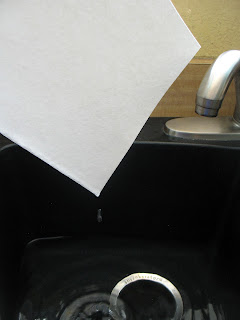Unless the paper you select to paint on is 300-lb. weight or heavier, it will need to be stretched. There are two reasons why this is necessary:
1 - To achieve a flat, tight surface and prevent the paper from buckling during the painting process, which causes the washes to puddle in the valleys.
2 - To break up the sizing on the surface of the paper. This sizing inhibits the initial washes from locking in the paper fibers.
There are several ways to stretch your paper, but I will describe and show the staple method, which I consider the fastest, easiest, and most effective. With this method, I use 140-lb, cold press watercolor paper, soaked and then stapled onto Gatorboard.
First, tear or cut your paper to the size you want. Have a piece of Gatorboard ready, that is a little bigger than your paper. Gatorboard is the best painting support I have found. It is lightweight and waterproof, and is available through most art supply stores and catalog companies. It's similar to the foamboard that framers use, but it is waterproof. Staples attach easily and can be removed easily when the painting is finished, and it can be used over and over again.
Soak your paper in a sink or tub, large enough to accommodate the paper. You don't need to soak it very long -- just make sure both sides of the paper are completely wet.
Then, drain off most of the water.
While it is still very wet, lay the paper onto the Gatorboard. Position the paper squarely on the board, and gently smooth it out with the back of your hand. (You don't actually stretch the paper.) I'm often asked which side of the paper is the "right" side for painting. I have found that it doesn't really matter. I just grab a piece of paper, stretch it, and start painting.
While the paper is still wet, staple it to the board around all 4 sides. Start stapling at the middle of an edge, and place staples about 2" apart.
Then, place your paper/board in a horizontal position, to let it dry completely. I try to stretch my paper at the end of the day, so it's dry by the next morning. (You can speed up the drying time with a hair dryer, if you need to.)
As it dries, it will buckle, but don't worry -- you didn't do it wrong. When the paper is absolutely dry, it will be as flat as the board and ready to paint on.
Do make sure the stretched paper is completely dry before beginning your drawing or painting. If the paper feels even slightly cold or damp, give it some more time.















































